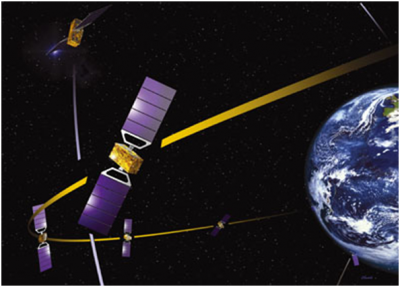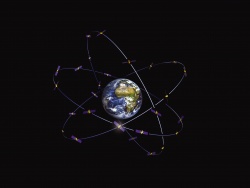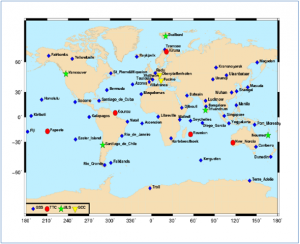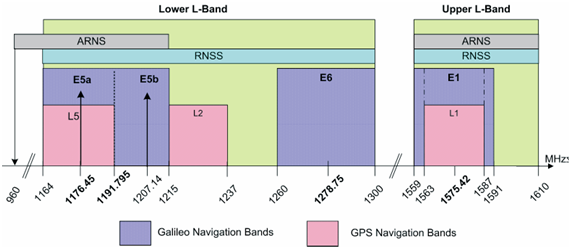If you wish to contribute or participate in the discussions about articles you are invited to contact the Editor
Galileo General Introduction: Difference between revisions
Angel.Gavin (talk | contribs) No edit summary |
Angel.Gavin (talk | contribs) |
||
| Line 58: | Line 58: | ||
The main functions of the [[GALILEO Space Segment|Galileo Space Segment]] are to generate and transmit code and carrier phase signals with a specific [[GALILEO Signal Plan|Galileo signal structure]], and to store and retransmit the navigation message sent by the [[GALILEO Ground Segment|Control Segment]]. These transmissions are controlled by highly stable atomic clocks on board the satellites. | The main functions of the [[GALILEO Space Segment|Galileo Space Segment]] are to generate and transmit code and carrier phase signals with a specific [[GALILEO Signal Plan|Galileo signal structure]], and to store and retransmit the navigation message sent by the [[GALILEO Ground Segment|Control Segment]]. These transmissions are controlled by highly stable atomic clocks on board the satellites. | ||
When Galileo is fully operational, there will be 30 satellites in Medium Earth Orbit (MEO) at an altitude of 23,222 kilometres. The satellites will occupy each of three orbital planes inclined at an angle of 56° to the equator. The satellites will be spread evenly around each plane and will take about 14 hours to orbit the Earth. One satellite in each plane will be a spare; on stand-by should any operational satellite fail. | When Galileo is fully operational, there will be 30 satellites in Medium Earth Orbit (MEO) at an altitude of 23,222 kilometres. The satellites will occupy each of three orbital planes inclined at an angle of 56° to the equator. The satellites will be spread evenly around each plane and will take about 14 hours to orbit the Earth. One satellite in each plane will be a spare; on stand-by should any operational satellite fail<ref name=GalileoCons30>[http://www.esa.int/esaNA/ESAAZZ6708D_galileo_0.html]Galileo : a constellation of 30 navigation satellites</ref>. | ||
[[File:Galileo Ground Segment.png|300px|Galileo Ground Segment|left|thumb]]The [[GALILEO Ground Segment|Galileo Control Segment]] (also referred to as Ground Segment) is the responsible for the proper operation of the GNSS system. Its basic functions are: | [[File:Galileo Ground Segment.png|300px|Galileo Ground Segment|left|thumb]]The [[GALILEO Ground Segment|Galileo Control Segment]] (also referred to as Ground Segment) is the responsible for the proper operation of the GNSS system. Its basic functions are: | ||
Revision as of 11:57, 25 November 2011
| GALILEO | |
|---|---|
| Title | Galileo General Introduction |
| Edited by | GMV |
| Level | Basic |
| Year of Publication | 2011 |
Galileo is Europe’s own global navigation satellite system, providing a highly accurate, guaranteed global positioning service under civilian control. It is inter-operable with GPS and GLONASS, the two other global satellite navigation systems. Galileo receivers compute their position in the Galileo Reference System using satellite technology and based on triangulation principles.
Introduction
The Galileo program is Europe's initiative for a state-of-the-art global satellite navigation system, providing a highly accurate, guaranteed global positioning service under civilian control.[1][2] While providing autonomous navigation and positioning services, the system established under the Galileo program will at the same time be interoperable with other GNSS systems such as GPS and GLONASS.[2] The system will consist of 30 satellites, to be deployed in a staggered approach, and the associated ground infrastructure.[3]
A user will be able to take a position with the same receiver from any of the satellites in any combination. By offering dual frequencies as standard, Galileo will deliver real-time positioning accuracy down to the meter range. It will guarantee availability of the service under all but the most extreme circumstances and will inform users within seconds of a failure of any satellite. This will make it suitable for applications where safety is crucial, such as running trains, guiding cars and landing aircraft.
The first experimental satellites, GIOVE-A (launched on 2005) and GIOVE-B (launched on 2008) have already tested critical technologies and secured the Galileo frequencies within the International Telecommunications Union. Thereafter, four operational satellites - the basic minimum for satellite navigation in principle - will be launched in 2011 to validate the Galileo concept with both segments: space and related ground infrastructure.
Based on the award of the contracts for the first order of satellites, the launch services, the system support services and the operations, the European Commission announced the Initial Operational Capability (IOC) with three initial services to be provided in 2014/2015: an initial Open Service, an initial Public Regulated Service and an initial Search and Rescue Service.[4] At this stage, accuracy and availability will not yet have reached their optimum level, the Safety-of-Life Service and the Commercial Service will be tested and will be provided as the system reaches full operational capability with the 30 satellites[5] Galileo will ensure Europe's independence in a sector that has become critical for its economy and the well-being of its citizens.
GPS (US), GLONASS (Russia) and the other regional systems developed by Japan and China are military systems under military control – indeed they provide a civil service but that civil service could be either switched off or made less precise when desired e.g. in case of conflict. The world has become so dependent on services provided by satellite navigation in our daily lives that should a service be reduced or switched off, the potential disruption to business, banking, transport, aviation, communication, etc., to name but a few, would be very costly (e.g. in terms of revenues for business, road safety, etc.).[6]
The combination of Galileo and GPS signals (inter-operability) in dual receivers will open the door to new GNSS applications that require a higher level of precision than currently available with GPS alone. From most locations, six to eight Galileo satellites will be visible which, in combination with GPS signals, will allow positions to be determined up to within a few centimetres. Examples of these applications are: guide the blind, increase the success rate of rescue operations in the mountains, monitor the whereabouts of people suffering from Alzheimer Disease, etc.[6]
In addition, Galileo will improve the overall availability and coverage of GNSS signals. For example, the higher number of satellites will improve the availability of the signals in high rise cities where buildings can obstruct signals from satellites that are low on the horizon.[6]
With Galileo, Europe will be able to exploit the opportunities provided by satellite navigation to the full extent. GNSS receiver and equipment manufacturers, application providers and service operators will benefit from novel business opportunities.[6][7]
History and Development
As far back as the 1990s, the European Union saw the need for Europe to have its own global satellite navigation system.[1] The conclusion to build one was taken in similar spirit to decisions in the 1970s to embark on other well-known European endeavours, such as the Ariane launcher and the Airbus. The European Commission and European Space Agency joined forces to build Galileo, an independent European system under civilian control.
The definition phase and the development and In-Orbit Validation phase of the Galileo program were carried out by the European Space Agency (ESA) and co-funded by ESA and the European Union. The Full Operational Capability phase of the Galileo program is fully funded by the European Union and managed by the European Commission. The Commission and ESA have signed a delegation agreement by which ESA acts as design and procurement agent on behalf of the Commission.
The Galileo program has been structured according to three main phases:[7]
- In-Orbit Validation (IOV) phase:
- The IOV phase consists of qualifying the system through tests and the operation of two experimental satellites and a reduced constellation of four operational satellites and their related ground infrastructure.
- The two experimental satellites were launched in respectively December 2005 and April 2008. Their purpose was to characterize the Medium-Earth Orbit (MEO) environment (radiations, magnetic field etc) and to test in such environment the performance of critical payload technology (atomic clocks and radiation hardened digital technology). They also provide an early experimental signal-in-space allowing securing the frequency spectrum required for Galileo in accordance with WRC RNSS allocations. The launch of the first two operational satellites is scheduled for end of 2011.
- Initial Operational Capability (IOC) phase:
- The IOC stage will be the partial commissioning of the ground and space infrastructure as from 2014-2015 and the provision of the open service, the search and rescue service and the PRS. While this first stage will be sufficient to test the services it should nonetheless be as short as possible, because it will not allow the system's full potential to be exploited and will not meet the requirements of all users.
- Full Operational Capability (FOC) phase:
- The FOC phase consists of the deployment of the full system which will consist of 30 satellites, control centres located in Europe and a network of sensor stations and uplink stations installed around the globe. Galileo's Full Operational Capability (FOC) should be achieved in 2019-2020, in a staggered approach from the IOC phase. It might change, depending on availability of financing, technical problems and industrial performance.
GALILEO Services
The Galileo mission and services have been elaborated during the initial definition phase in consultation with user communities and the Member States. The services that are planned to be provided by Galileo are the following:[5]
- Open Service (OS): With positioning accurate to one metre, the freely accessible Open Service targets the mass market and is intended for motor vehicle navigation and location-based mobile telephone services. Free to the user, it provides positioning and synchronization information intended for high-volume satellite radio navigation applications;
- Safety-of-Life Service (SoL): The Safety of Life service will automatically inform users within seconds of a failure of any satellite or similar problem affecting performance. This service will be made available for safety-critical applications such as running trains, guiding cars, navigation and aviation. This service also fulfils the requirements of certain sectors for continuity, availability and accuracy and includes an integrity function alerting the user of any failure in the system;
- Commercial Service (CS): Encrypted and accurate to the nearest centimetre, the Commercial Service allows for development of applications for professional or commercial use owing to improved performance and data with greater added value than that obtained through the open service;
- Public Regulated Service (PRS): The Public Regulated Service is restricted to government-authorised users, for sensitive applications which require a high level of service continuity. It will be encrypted and designed to be more robust, with anti-jamming mechanisms and reliable problem detection. This service is intended for security and strategic infrastructure (e.g. energy, telecommunications and finance);
- Search and Rescue Service (SAR): Galileo's worldwide search and rescue service will help to forward distress signals to a rescue coordination centre by detecting emergency signals transmitted by beacons and relaying messages to them.
GALILEO Architecture
To ensure these Galileo services, a specific architecture is deployed. The Galileo system is divided into three major segments: Space Segment, Control Segment and User Segment. For details see Galileo Architecture.
The main functions of the Galileo Space Segment are to generate and transmit code and carrier phase signals with a specific Galileo signal structure, and to store and retransmit the navigation message sent by the Control Segment. These transmissions are controlled by highly stable atomic clocks on board the satellites.
When Galileo is fully operational, there will be 30 satellites in Medium Earth Orbit (MEO) at an altitude of 23,222 kilometres. The satellites will occupy each of three orbital planes inclined at an angle of 56° to the equator. The satellites will be spread evenly around each plane and will take about 14 hours to orbit the Earth. One satellite in each plane will be a spare; on stand-by should any operational satellite fail[8].
The Galileo Control Segment (also referred to as Ground Segment) is the responsible for the proper operation of the GNSS system. Its basic functions are:
- To control and maintain the status and configuration of the satellite constellation.
- To predict ephemeris and satellite clock evolution.
- To keep the corresponding GNSS time scale (through atomic clocks).
- To update the navigation messages for all the satellites.
The Galileo Ground Segment constitutes the major system element controlling the entire constellation, the navigation system facilities and the dissemination services. It is composed of two Ground Control Centres (GCC), five Telemetry, Tracking and Control (TT&C) stations, nine Mission Uplink Stations (ULS), and tens of Galileo Sensor Stations (GSS), nominally 30.
The Galileo user segment is composed by Galileo receivers. Their main function is to receive Galileo signals, determine pseudoranges (and other observables), and solve the navigation equations in order to obtain their coordinates and provide a very accurate time.
Galileo Signal Characteristics
The Galileo navigation Signals are transmitted in the four frequency bands indicated in next figure. These four frequency bands are the E5a, E5b, E6 and E1 bands. They provide a wide bandwidth for the transmission of the Galileo Signals.[9]
The Galileo frequency bands have been selected in the allocated spectrum for Radio Navigation Satellite Services (RNSS). In addition to that, E5a, E5b and E1 bands are included in the allocated spectrum for Aeronautical Radio Navigation Services (ARNS), employed by Civil-Aviation users, and allowing dedicated safety-critical applications. The names of the Galileo signals are the same as the corresponding carrier frequencies. Note that E5a and E5b signals are part of the E5 bandwidth.[9]
GALILEO Performances
The Galileo performances are different for each service. For the Galileo Open Service (OS) no specific requirements of integrity are applicable. The performances for horizontal positioning accuracy at 95% for a dual-frequency receiver are 4 m (8 m for vertical accuracy), with an availability of the service of 99%.
In the case of the Galileo Safety of Life (SoL) and the Galileo Public Regulated Service (PRS), the performance requirements include horizontal and vertical accuracy, integrity, continuity and time to alert for different service levels. The availability of the service should be 99.5% for both services.
See the article Galileo Performances for further information.
Credits
Edited by GMV, using information from ESA and European Union as indicated through the references.
Notes
References
- ^ a b Council Resolution of 19 July 1999 on the involvement of Europe in a new generation of satellite navigation services -Galileo- Definition phase (1999/C 221/01)
- ^ a b The European Satellite Radio Navigation Programmes Galileo and EGNOS: Questions and Answers, European Union Press Release 23/05/2011
- ^ ESA Galileo web page
- ^ Commission awards major contracts to make Galileo operational early 2014, IP/10/7, Brussels, 7 January 2010.
- ^ a b Mid-term review of the European satellite radio navigation programmes
- ^ a b c d Satellite Navigation, Why Galileo?, European Commission web.
- ^ a b EC Galileo website
- ^ [1]Galileo : a constellation of 30 navigation satellites
- ^ a b Galileo OS SIS ICD Issue 1 Revision 1 September 2010e




